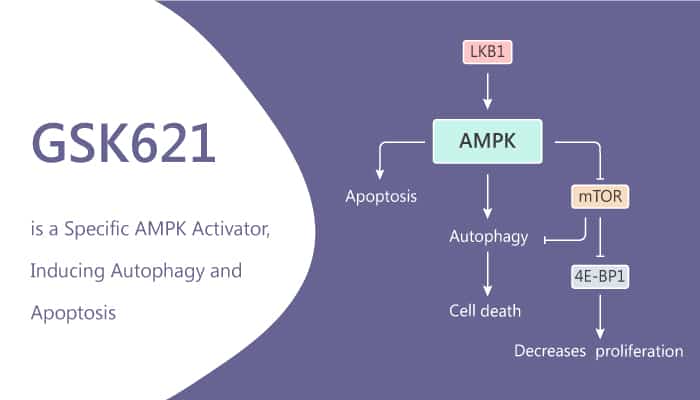AMPK is an enzyme, which plays a role in cell energy homeostasis. It mainly activates glucose and fatty acid uptake and oxidation when the cell energy is low. Specifically, AMPK is a major regulator of cell metabolism, which can exert its carcinogenic or antitumor activities. Besides, the activation of AMPK inhibits the protein synthesis of mammalian rapamycin complex 1 (mTORC1) target. Moreover, AMPK inhibits fatty acid biosynthesis by inactivating acetylcocoa carboxylase (ACC) phosphorylation. At the same time, AMPK also promotes catabolism, including glucose uptake and subsequent glycolysis, fatty acid oxidation, and autophagy. Furthermore, AMPK seems to be a tumor suppressor or an oncogene. The indirect AMPK activator metformin has activity in acute myeloid leukemia (AML) cell line model. GSK621 is a potent and specific AMPK activator and induces autophagy and apoptosis.
GSK621 is a specific AMPK activator and induces autophagy and apoptosis.

How does GSK621 work on the target? Let’s study it together. In the beginning, GSK621 is a specific AMPK activator, with IC50 values of 13-30 μM for AML cells. Meanwhile, GSK621 induces autophagy and apoptosis and induces eiF2α phosphorylation-a hallmark of UPR activation.
In the second place, GSK621 induces AMPKα T172, ACC (S79) and ULK1 (S555) phosphorylation. Nonetheless, GSK621 induces autophagy and apoptosis. GSK621 treatment also induces PERK phosphorylation, a marker of ER stress, in AML cells. Importantly, GSK621 reduces the proliferation of all 20 lines and increased apoptosis in 17 (85%) lines.
Last but not the least, GSK621 exhibits significant anti-tumor activity in MOLM-14 cells xenograft. Particularly, GSK621 reduces leukemia growth and significantly extended survival compared to vehicle-treated animals or those treated with 10 mg/kg twice daily. Cytotoxicity in AML cells from GSK621 involves the eIF2a/ATF4 signaling pathway that specifically results from mTORC1 activation.
All in all, GSK621 is a potent and specific AMPK activator and induces autophagy and apoptosis.
References:
Pierre Sujobert, et al. Cell Rep. 2015 Jun 9;11(9):1446-57.